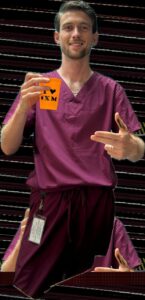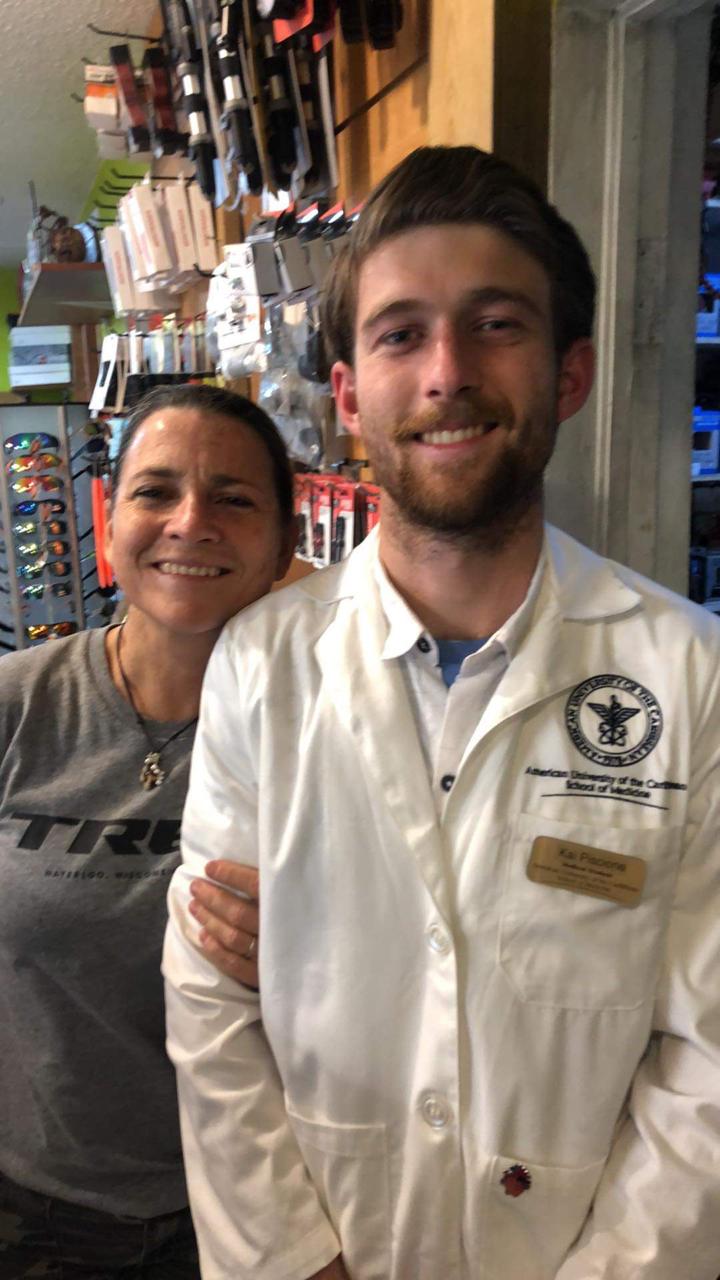By Ria Uiterloo
February 20, 2025
Education extends beyond academics; it involves fostering an environment that nurtures the whole child—mind, body, and spirit. Kai Piscione’s journey demonstrates the transformative impact of a supportive school environment, engaged parents, and a strong focus on well-being. Now a medical student preparing for his residency in the UK, Kai and his parents reflect on the challenges he faced as a young student and the ways in which a holistic approach to education helped shape his journey.
During a recent visit to the American University of the Caribbean School of Medicine, I felt compelled to reconnect with Kai, a former student of Sr. Regina School, where I served as school manager. Though I didn’t see him that day, I later encountered his mother and shared my pride in his achievements. She recounted the pivotal decision to research his diet following the challenges he faced in school, leading to a transformative change in his focus and behavior. Recognizing the significance of their journey, I felt it was crucial to share their experience as an eye-opener for parents, educators, and policymakers. In an interview with Kai and his parents, they provided insight into their challenges, decisions, and successes.
Kai struggled with focus and concentration from an early age, often feeling misunderstood and frustrated in traditional learning environments. Kai’s high energy levels made it challenging for teachers to accommodate him, sometimes resulting in disciplinary actions. However, sports and recess provided him with an outlet where he could move freely and express himself.
Recognizing the need for a different approach during my years as school manager, the school implemented Experiential Education, which emphasized student autonomy, involvement, and well-being. This concept introduced “contract work,” where students were given a mix of structured tasks and free-choice activities, allowing them to take ownership of their learning.
Did this approach help Kai? While he enjoyed hands-on projects and group activities, he later realized that he thrived best with clear direction and structured guidance. He explains “It didn’t help me much. I needed more structure and guidance rather than autonomy. Having clear goals and a defined method worked better for me.” However, the shift in learning culture fostered essential skills—organization, self-awareness, and an understanding of his own learning preferences. “It helped my organizational skills, and it did help me to learn what I liked and what I wanted to learn more of”, he shares.
The role of family and lifestyle changes
Kai’s parents, Susy and Pablo, played a crucial role in his development. As active members of the school community, they not only participated in PTA initiatives but also took a proactive approach in addressing Kai’s concentration difficulties. “When faced with the suggestion of medical intervention for possible ADHD, we sought alternative solutions, starting with nutrition. From an early age, as young as 6 months, Kai was very active and busy, but we noticed that it was a problem in group 8 when we were told he would need specialized approaches 

or medical attention to finish school. The complaints of the teachers and other parents that Kai was disrupting the class and affecting everyone else’s ability to learn made us feel so bad and guilty. The last two years of primary school were especially difficult”, Susy shares.
Through extensive research, Susy discovered the effects of Red Dye 40, a common food additive linked to hyperactivity in children. Kai’s daily breakfast included pancakes with syrup containing Red Dye 40, unknowingly worsening his concentration issues. The very next day after eliminating Red Dye 40 from his diet, teachers noticed an immediate improvement in his focus and behavior.
Kai’s family transitioned to a cleaner diet, avoiding artificial colorings and preservatives. The results were undeniable, his ability to concentrate improved significantly, and he became more engaged in school. This discovery highlighted an often-overlooked factor in children’s cognitive and behavioral health: the direct link between nutrition and learning outcomes.
Choosing the right educational path
Recognizing Kai’s need for a smaller, more personalized learning environment, his parents enrolled him at the Charlotte Brookson Academy for the Performing Arts. While the school faced challenges, particularly in its early years, it provided a space where Kai could explore his interests, build meaningful friendships, and receive individualized attention. A pivotal moment came when a science teacher recognized his potential and inspired him to pursue a career in medicine.
After completing the CXC program at Charlotte Brookson Academy, Kai spent a year at the Canadian International School in Cupecoy, a decision his parents believed was the right path to prepare him for studying Biology Applied to Forensics at the University of the West of Scotland. He continued to excel academically and was awarded the prestigious Court Medal for Applied Bioscience with Forensic Investigation at the BSc Level 7.
Thriving in medical school
Today, Kai is on the verge of completing the first two years of medical school (Board exam) and preparing for his two-year clinical rotation in hospitals in the UK or the USA this year. Kai explains that to become a certified doctor, he must pass another board exam after his clinical years, which will qualify him to practice medicine. This certification will also allow him to apply for a residency at a hospital of his choice, where he can specialize in forensic and clinical pathology. With a strong passion for pathology, Kai envisions returning to St. Maarten after his studies to contribute to the medical field, either by establishing his own pathology lab or advancing forensic and clinical pathology services on the island.
Kai attributes much of his success to the strong foundation laid during his early years. His ability to manage multiple cases, transition between complex topics, and maintain discipline in a demanding field stem from the lessons he learned in school and at home. He also remains committed to a healthy lifestyle, avoiding artificial additives and prioritizing a balanced diet to sustain peak mental performance. ‘Sports has always been, and continues to be, essential to his development,’ say his parents, Pablo and Susy Piscione, owners of TRI-SPORT in Simpson Bay, who exemplify a healthy lifestyle and a deep commitment to sports.
When asked what advice he would give to children struggling with concentration, Kai emphasizes the importance of diet, environment, and peer support. He encourages parents to be mindful of their children’s nutrition, cultivate positive friendships, and create a structured yet nurturing learning environment.
Lessons for schools, parents, and policymakers
Kai’s journey powerfully illustrates the importance of Healthy Schools and Communities, emphasizing how education should extend beyond academics to include nutrition, physical activity, and mental well-being. His parents offer valuable insights:
Reevaluate nutrition: Artificial additives like Red Dye 40 can have significant effects on children’s attention and behavior. Schools and parents must prioritize fresh, natural foods.
Engage in active learning: A rigid, traditional classroom may not work for every child. Hands-on activities, sports, and interactive learning can enhance engagement.
Prioritize well-being over standardization: A child’s mental and emotional health is just as critical as their academic performance.
Empower parents with knowledge: Many behavioral issues can be addressed through informed lifestyle changes. Encouraging awareness can lead to proactive, effective solutions.
As we continue to shape the future of education, Kai’s story serves as a reminder that a child’s success is built through collaboration between schools, families, and communities. By prioritizing well-being, we can create learning environments that empower every child to reach their full potential.
For more information, see links: https://health.clevelandclinic.org/red-dye-40
https://www.healthline.com/nutrition/red-dye-40


